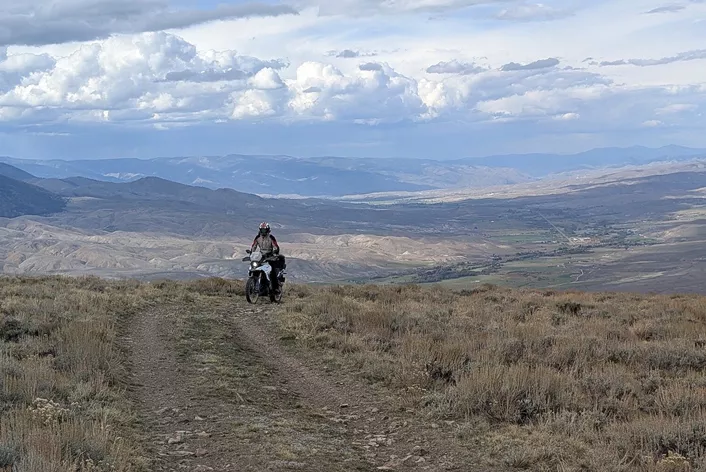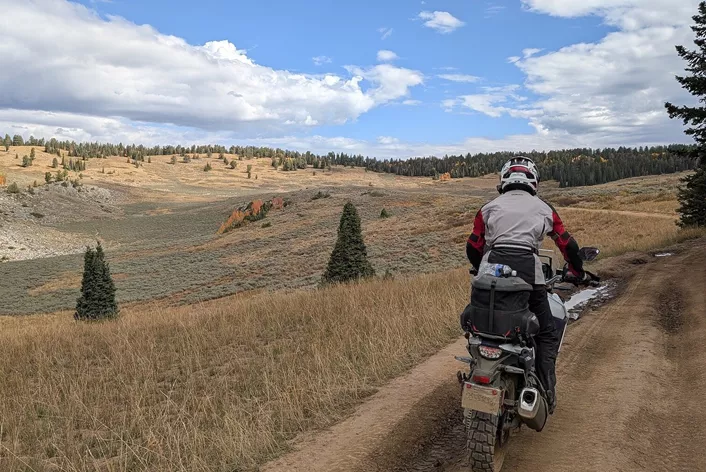Wow – what a start! Right after setting off from Edge Powersports in Salt Lake City, we plunged into the autumnal Wasatch Mountains with our V-Stroms, leaving the manicured suburbs and garden tranquility quickly behind. The ride up I-80 to the 2,170-meter-high Parleys Summit delivered a first curvy spectacle and stunning views of bright yellow aspens, birches, and deep red autumn slopes, while eagles soared above and the first deer at the roadside added to the authentic Wild West vibe. A detour to the turquoise Bear Lake – the "Caribbean of the Rockies" – would've made the day perfect but fell victim to our tight schedule. Instead, the detour to Park City rewarded us with an intriguing mix of mining history, Olympic flair, and laid-back Main Street vibes. Further north, the solitary Liberty-Avon Road awaited with a roughly 20-kilometer delight in the terrain: fine gravel, moderate climbs, and a pass at nearly 1,900 meters – perfect for big adventure bikes with 50/50 tires and a great taste of adventures to come. After a final sweep over twisty asphalt sections, we reached Logan, once the base of trapper Ephraim Logan, now a vibrant university town with around 52,000 residents and a worthy stop after this intense first day of riding. We're in the thick of it now! In a sparsely populated region of the USA – with our adventure bikes – ready for more adventures.
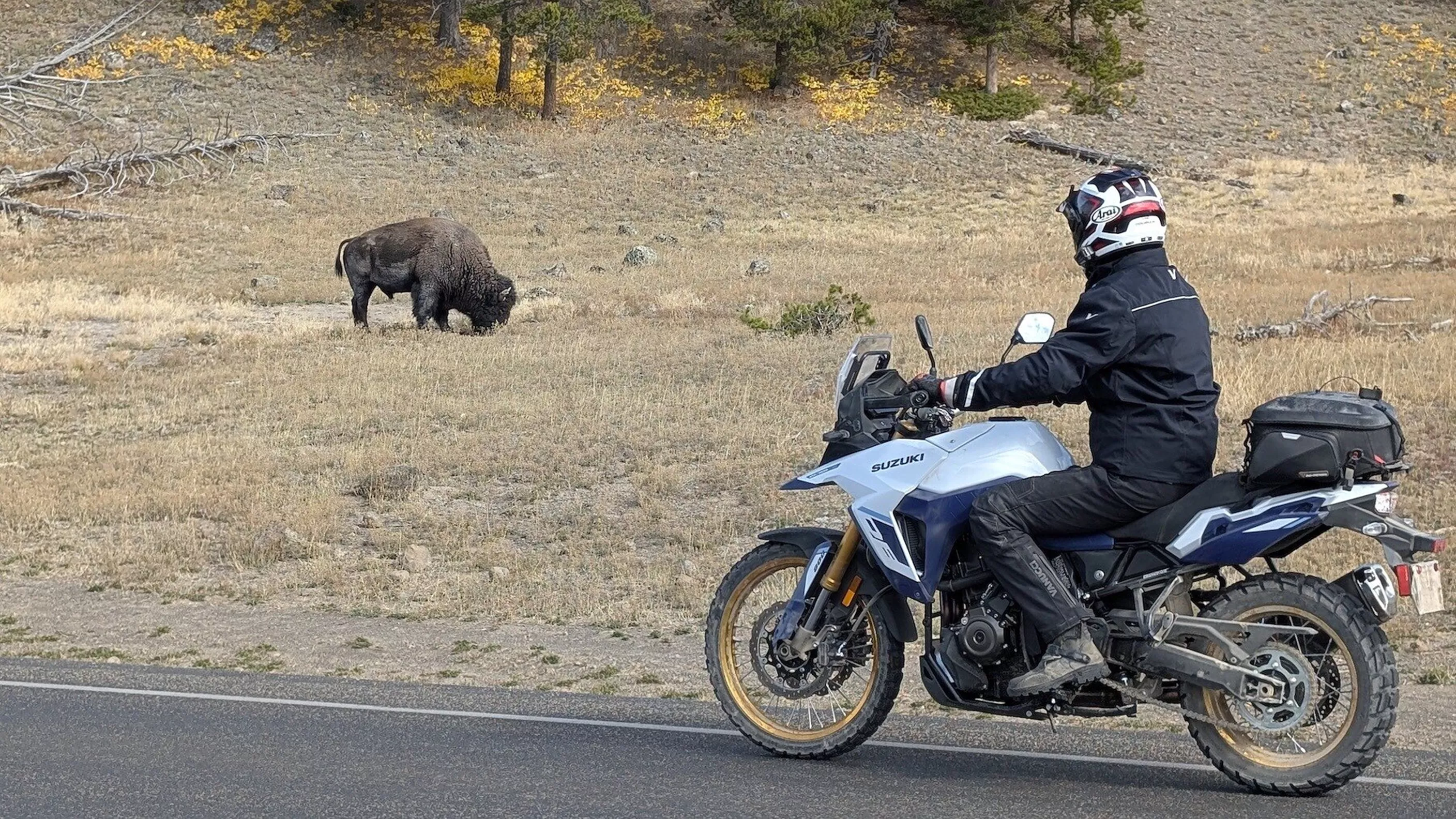
Motorcycle Adventure to Yellowstone National Park
Bison, Bears, and the Wild West! 2700 km with the Suzuki V-Strom
The destination is set! Dive into the mighty wilderness of North America at Yellowstone National Park. In the saddle of the V-Strom 800DE. The journey there is adventurous and magnificent. 2,700 km! Mostly off-road!
&width=72&height=72&bgcolor=rgba_39_42_44_0&mode=crop)
nastynils
published on 11/10/2025
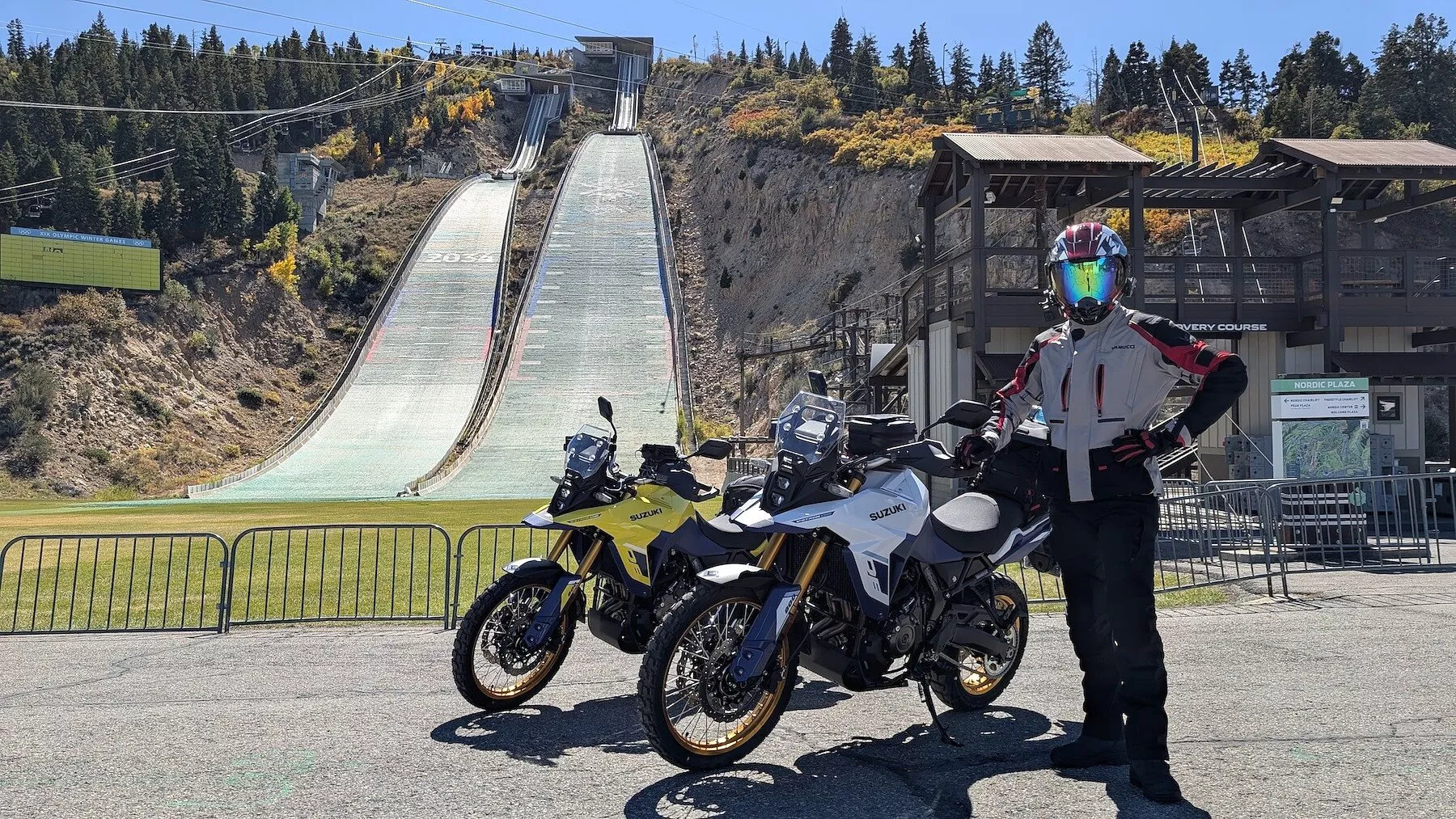
We spared ourselves and the V-Strom the leap off the Park City Olympic Ski Jump!
Trip Preparations - How Do We Carry Our Gear on the Motorcycle?
On our journey, we had to make intentional compromises with our luggage, and it turned out to be a spot-on decision. Instead of opting for heavy pannier systems, we chose the SW-Motech PRO Rearbag, which is perfectly designed for air travel and quick mounting, thanks to its variable volume of 22 to 34 liters, lightweight of just 1.8 kg, and robust 1680D ballistic nylon construction. With the four provided loop straps, the bag sat rock-solid on both the luggage rack and the pillion seat, even after long off-road stretches over the Liberty-Avon Road or dusty mountain tracks. The non-slip base and thoughtful strap management prevented any shifting, while the smooth zipper stood up to countless dusty miles without faltering. Practical for everyday travel: The MOLLE top allowed us to securely attach a water bottle or additional pouches, and the removable inner bag made handling luggage at accommodations pleasantly simple. Although the bag sits a bit higher than side cases, raising the center of gravity—a point smaller riders will notice when mounting—the bike remains pleasantly narrow and agile. For us, this solution was a prime example of how well-thought-out soft luggage on a big adventure bike can be uncompromisingly robust and yet absolutely practical. This bag was the centerpiece of our luggage strategy, complemented by a waterproof tank bag for the drone and camera. It doesn’t get more compact than this—essential for tackling upcoming off-road sections with luggage.
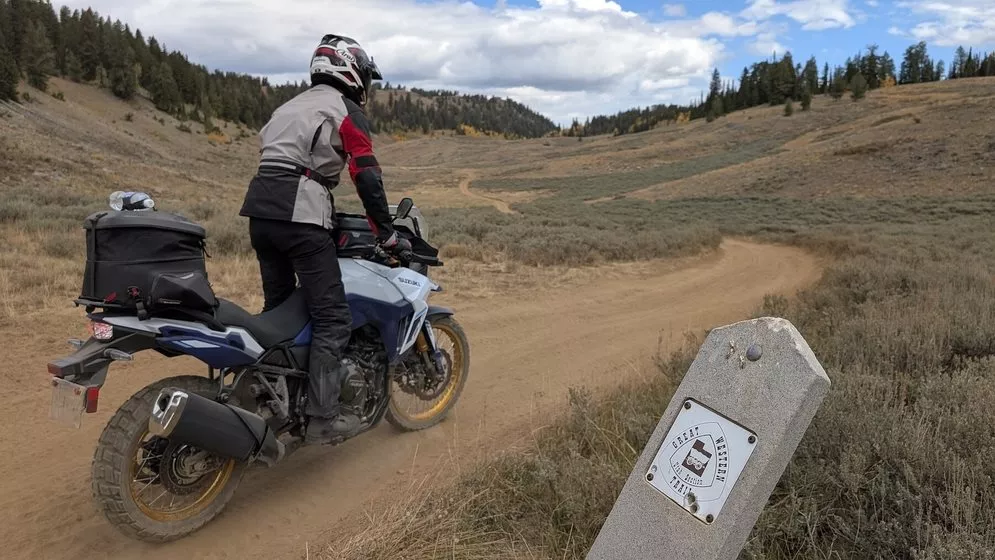
The SW-MOTECH rear bag does sit a bit high, but it keeps the motorcycle pleasantly narrow.
Have We Arrived in the Caribbean? Turquoise Waters High in the Mountains!
On the second day of our USA trip, it was all about pure off-road joy. Early in the morning, we rolled out of Logan and finally set course for the turquoise shimmer of Bear Lake—covering a total of 305 kilometers and climbing up to 2,638 meters in altitude. The temperature variations were vast: from the cool morning mist in Logan Canyon to the mild autumn sun by the lake. Right from the start, the legendary Franklin Basin Road led us across the state line into Idaho—a classic among adventure riders, where winding forest passages and fast gravel straights alternate. Today, we managed to include Bear Lake in our route. At the shores of Bear Lake in Garden City, we marveled at the water's unparalleled color before heading to Montpelier, a historic junction of the Oregon Trail, where a small museum commemorates the pioneer era. A special treat was a section at Peter Sinks, notorious as one of the coldest places in North America: Today, the thermometer showed a pleasant 15°C, though winters here have seen temperatures as low as -56°C. The trail itself offered off-road fun with a difficulty level of 4 out of 10—perfectly manageable with our V-Stroms without any stress. We ended the day in the picturesque Star Valley in Wyoming, surrounded by cattle herds, clear rivers, and endless mountain panoramas—a day that offered everything one loves about a grand adventure tour.
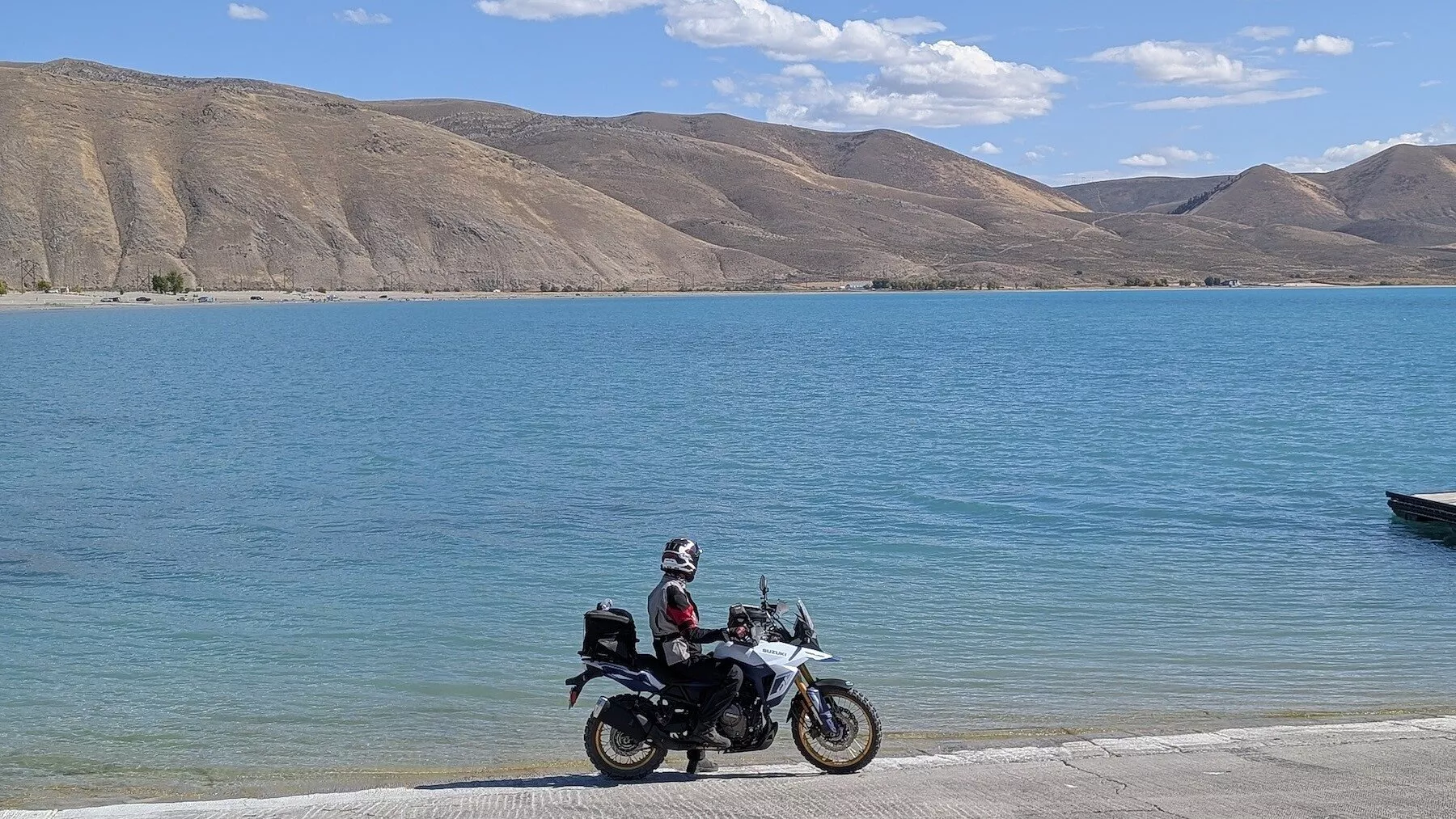
Crystal clear water - but cold! We're at an elevation of 1,802 meters!
50/50 - This Time with the Best of Both Worlds
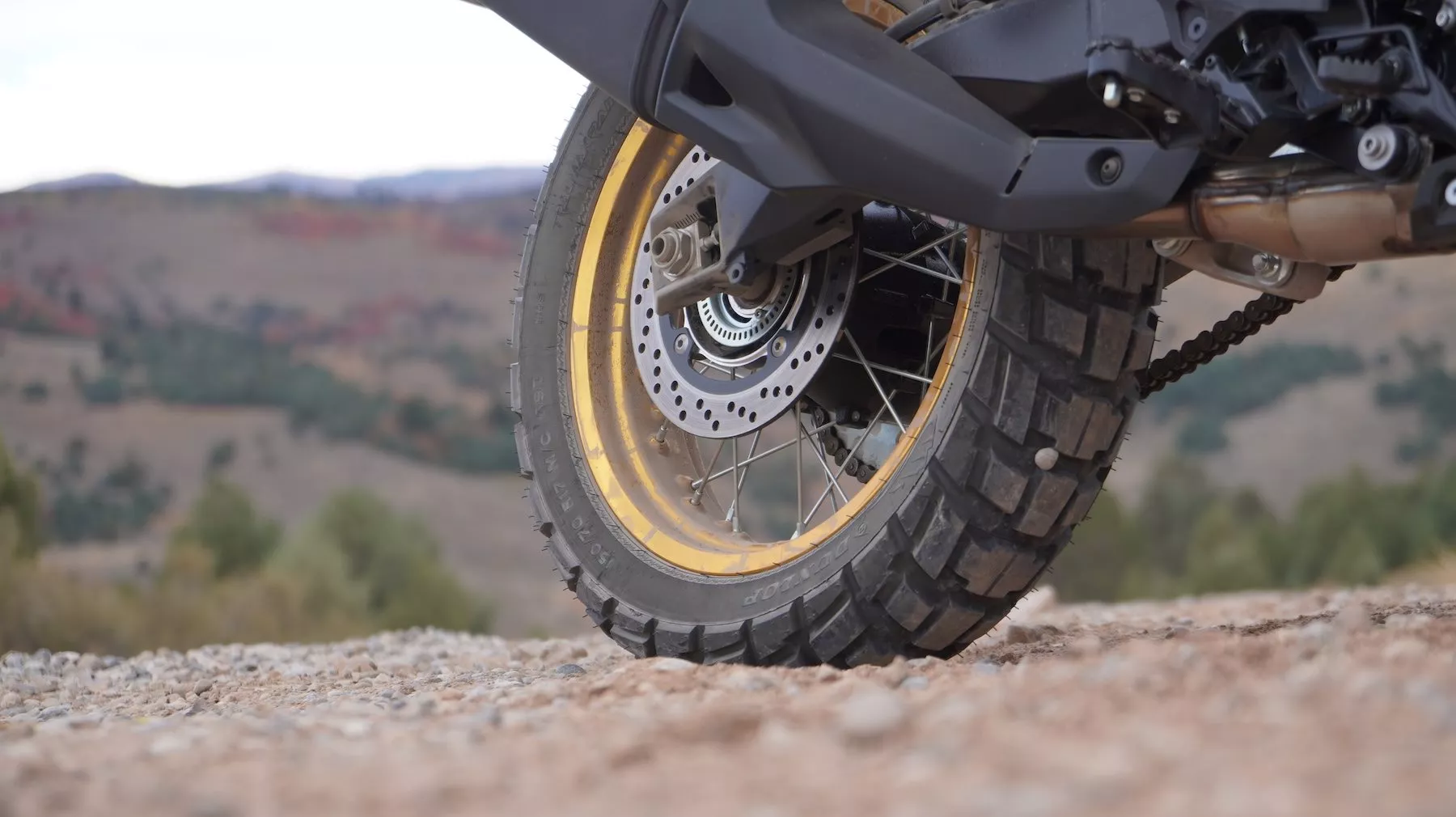
Dunlop Trailmax Raid - Our First Choice for the Demanding Journey
On our approximately 2,700-kilometer tour through Utah, Montana, Idaho, and Wyoming, we equipped both Suzuki V-Strom 800 DEs with the Dunlop Trailmax Raid – and it proved to be an excellent choice for this highly versatile journey. After thorough research, we consciously chose this 50/50 tire from Dunlop because it perfectly bridges the gap between road and off-road use for us. Thanks to its silica compound, it offers reliable grip on wet asphalt without compromising the fun on dry twisty roads. Simultaneously, it delivered impressive traction and self-cleaning capabilities on gravel and light trails. Compared to our previous favorite, the Dunlop D908RR, the Trailmax Raid stands out particularly in wet conditions with significantly more reserves and a smoother ride. Typical for this tire class, there is a slight stand-up tendency when braking in a lean, and it follows grooves on asphalt more than purely road-oriented tires – a compromise we gladly accepted for its immense versatility. With an expected mileage of 5,000 to 7,000 kilometers, smooth running, and comfortable rolling, the Trailmax Raid guided us safely and reliably through all the weather and road conditions of the Yellowstone adventure.
Blazing at 70 Miles on Gravel!
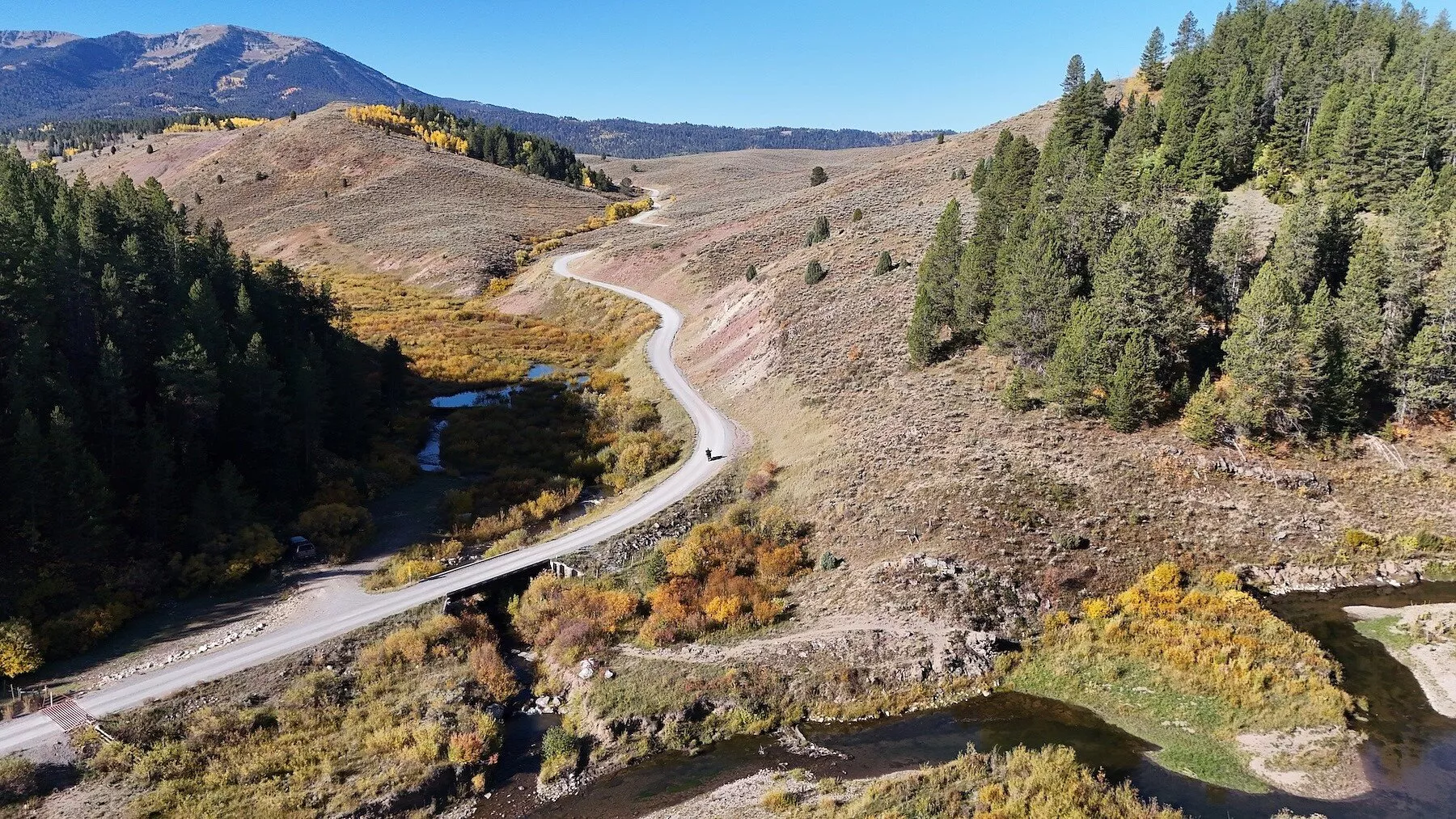
Stunning gravel trails! We enjoyed the vastness from the saddle of our adventure bikes!
On the third day of our tour, we and our two Suzuki V-Strom 800DEs had about 320 kilometers on the agenda—a wild mix of fast gravel tracks and steep, short ramps that demanded everything from us and simultaneously put a wide grin on our faces. With an average speed of 58 km/h and top speeds over 70 miles per hour on loose surfaces, we shot over wide gravel highways, only to be challenged again at sharp inclines with a difficulty level of 4 out of 10. The V-Strom and the mounted Dunlop tires once again proved to be a perfect team—super confident, stable, and always ready for the next challenge. The only thing we sorely missed that day was heated grips. In the morning, the thermometer showed a frigid 1°C, and it wasn't until the afternoon that the temperature climbed to nearly 25°C. Our American test machines are traditionally a bit more spartan than European models: fewer comfort features like heated grips or cruise control, but at least a quickshifter that made the sporty sprints in between a pleasure.
My Vanucci gear was also put to the test today. In the morning, I donned the rain jacket and a warm sweater. During the day, I removed these layers and opened the ventilation zippers again. Once again, I appreciated the combination of freedom of movement and riding comfort.
The route led us almost all day through the Caribou-Targhee National Forest, a vast natural paradise of over 12,000 km² on the border of Idaho, Wyoming, and Utah. Between 1,400 and 2,300 meters in elevation, the landscape changed by the minute: dry sagebrush valleys, fragrant pine forests, wide mountain meadows, and repeated expansive views of the volcanically shaped Island Park Caldera. The cool night air made the atmosphere crystal clear, the light razor-sharp, the colors glowing in all shades of gold, ocher, and deep pine green. The dry air ensures little precipitation here, as the Rocky Mountains intercept the Pacific moisture—a blessing for photographers, even though the fine dust on the gravel tracks challenged every piece of equipment. Accordingly, not only off-road adventurers populated the area this Saturday but also hikers, hunters, and anglers who were savoring the last warm autumn days. With every kilometer, the grand finale of our journey was drawing closer: Yellowstone National Park was already within reach—a fitting outlook for a day that thrilled us with speed, technology, and nature in equal measure.
1 Year of Preparation for This Trip - Our Motorcycle Choice: Suzuki V-Strom 800DE
On our intensive test tour through 4 states—with daily off-road sections of up to 80–90%—the Suzuki V-Strom 800DE impressively demonstrates why it is currently one of the most exciting mid-range adventure bikes on the market. Despite extremely fast gravel tracks with relentless bumps, constant vibration, and heavy dust exposure, it exudes a calmness and confidence that's hard to match. Even in temperatures ranging from 1°C in the frosty mornings to 30°C in the afternoons and at altitudes from 800 to over 2,500 meters, the newly developed 776cc parallel-twin engine with a 270° crankshaft operates absolutely reliably—only at the highest elevations is a slight power drop noticeable. With its 84 hp at 8,500 rpm, 78 Nm at 6,800 rpm, patented Cross-Balancer technology, and a real-world consumption of just 4.5 l/100 km, the engine remains a true highlight. The combination of smoothness, agility, and practicality makes it a superstar in the current adventure bike market.
The suspension, with 220 mm of travel front and rear, 220 mm ground clearance, a stable steel tube frame, and the 21-inch front wheel (90/90-21) and 17-inch rear wheel (150/70-17), shows practical reserves on rough high-speed gravel tracks. The fully adjustable Showa suspension feels comfortable in the standard setup but remains remarkably stable for our mix of fast gravel tracks and slow passages. We set the suspension very soft to enjoy greater ride comfort over the bumps.
Despite its ready-to-ride weight of 230 kg, the 800DE feels pleasantly nimble and offers good seating comfort. We would have only wished for cruise control for the connecting stages and heated grips for the chilly mornings.
Conclusion after kilometers over endless gravel tracks, mountain passes, and highways: The Suzuki V-Strom 800DE is a robust all-rounder that excels equally on long connecting stages as it does in rough terrain—a motorcycle that effortlessly bridges the gap between comfort and adventure, something we've rarely seen in this price range. During our tour, we repeatedly mentioned how reliably and confidently the bike performs here. Needless to say, we returned the Japanese bikes to the dealer after 2,700 km without a scratch, issue, or defect.
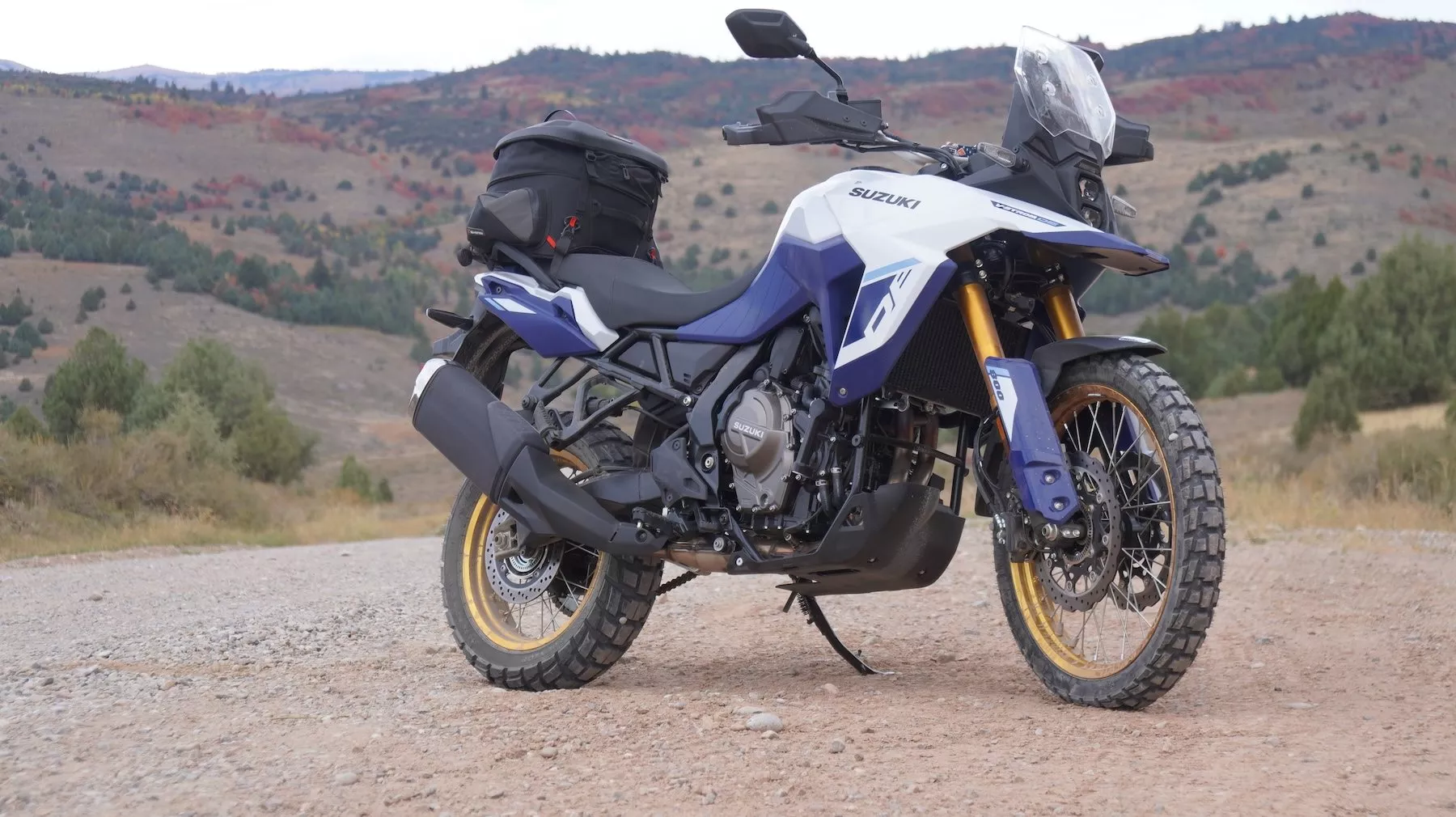
Our first choice for this journey: Suzuki V-Strom 800DE
Riding Through Yellowstone National Park
Today's ride began with an icy awakening: overnight, a thin layer of frost had settled on the seats of our Suzuki V-Strom 800DEs. The thermometer still read a relentless 1°C in the morning, and even our newly purchased glove warmers from the outdoor shop offered little relief. The journey to West Yellowstone was more teeth-chattering than enjoyable, and it was only a hearty breakfast in a warm diner that revived our spirits. Refreshed, we patiently joined the long line of cars at the park entrance—in the U.S., lane-splitting on motorcycles is not customary—got our passes, and immersed ourselves in the vast expanse of Yellowstone National Park, the world's first national park (established on March 1, 1872).
Barely past the gate, the full scale of this natural wonder unfolded: about 3,500 square miles, spanning three states (Wyoming, Montana, and Idaho) and shaped by a geological supervolcano caldera, which still records 1,000 to 3,000 earthquakes per year. The ride revealed countless hot springs, geysers, mud pots, and fumaroles strung like pearls. Over 500 active geysers bubble here—the highest concentration in the world—including legends like Old Faithful, which erupts approximately every 88 minutes. At the boardwalks, short trails lead directly to vibrant pools such as the emerald green Emerald Pool or the deep blue Abyss Pool, where yellow sulfur edges and bacterial color rings blend into surreal images.
But it's not just the bubbling earth that fascinates: everywhere, streams babble, rivers rush, and lakes like the gigantic Yellowstone Lake—the largest high-altitude lake in North America at over 2,100 m—glitter. For me, though, the wild animals remain the true highlight. We spotted the famous bison multiple times, sometimes far off in the grasses, and once a ton-heavy behemoth stood completely unfazed right in front of our V-Strom on the road—a moment that humbles even the most seasoned riders. Despite the busy Sunday traffic, it was a nature experience of rare intensity, and on two wheels, you enjoy the unbeatable advantage of always finding a spot at the crowded parking lots of major attractions. A brief afternoon shower only highlighted how masterfully the Dunlop Trailmax Raid handles wet roads.
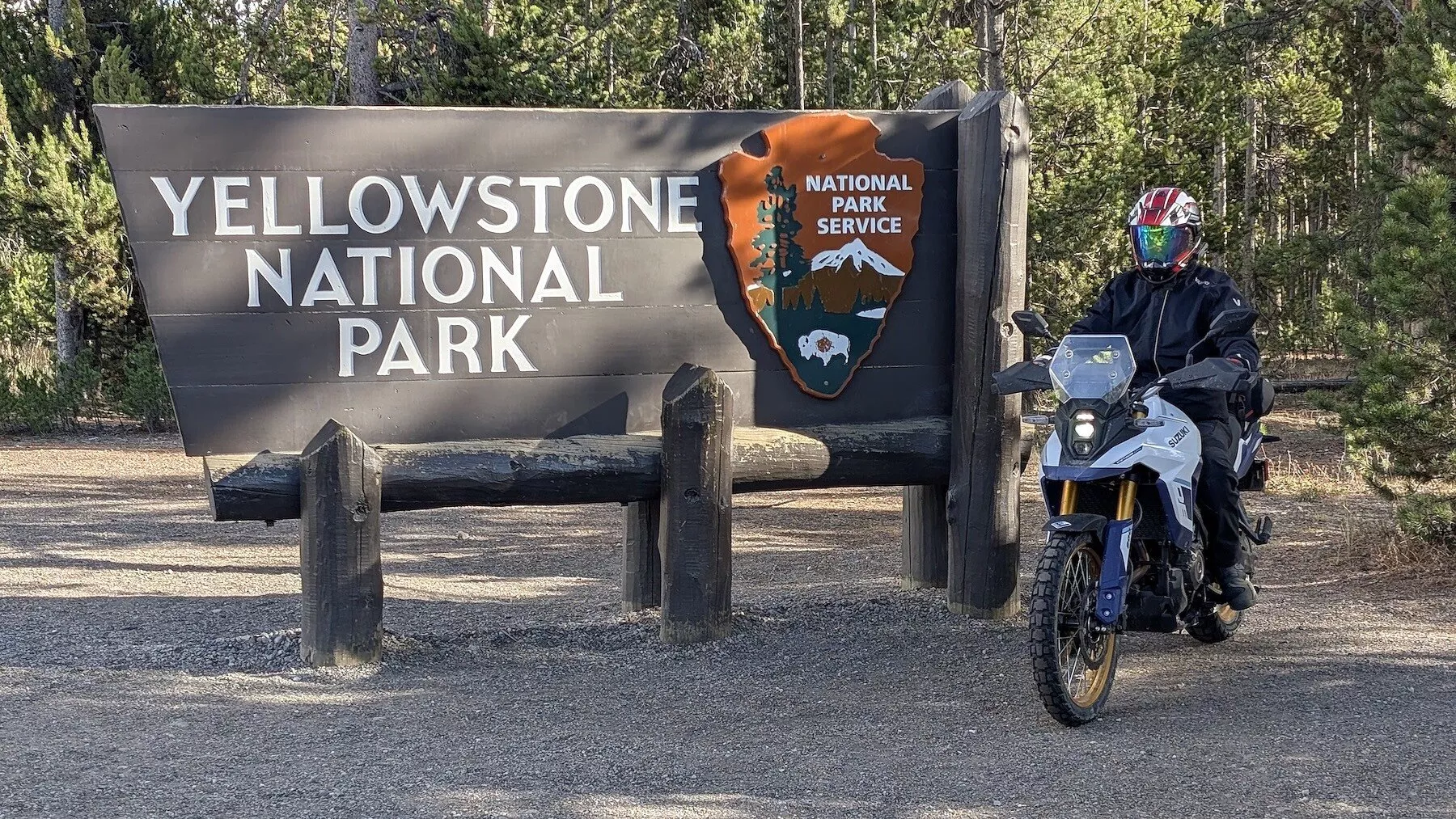
Gear - It Must Be Lightweight, Comfortable, and Versatile!
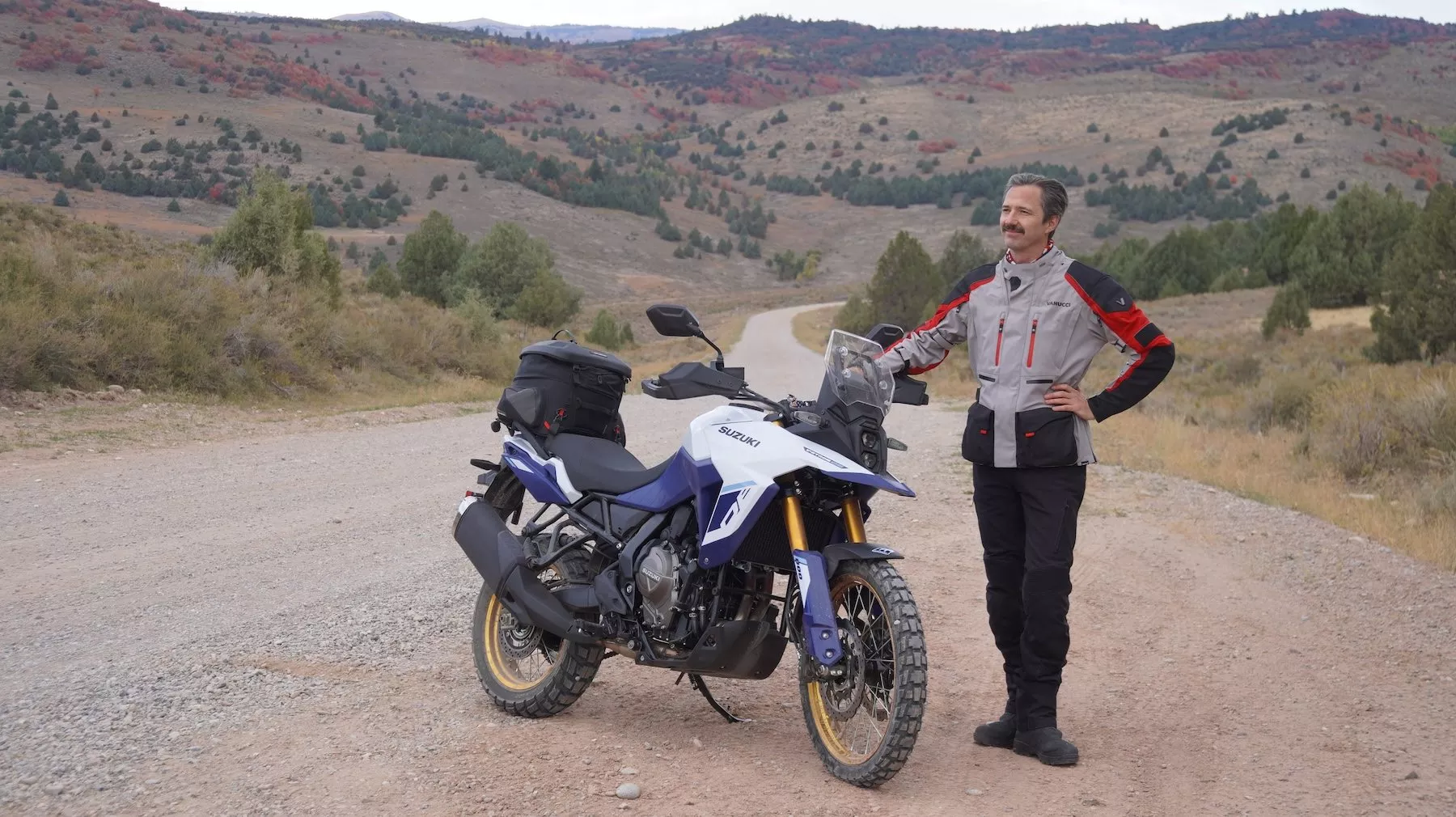
On my journey through Montana, Utah, Wyoming, and Idaho, I had the opportunity to test the complete Vanucci gear in a genuine long-distance setting—and it proved to be a very practical package. The compromise I needed to solve wasn't simple—the entire luggage, including the SW-Motech luggage system, had to stay under 23 kg and fit into a travel bag. On the other hand, it had to perform well during both hot enduro stages and frosty highway legs. Here's my selection:
The VAG-4 gloves were versatile and handled the wildly fluctuating temperatures surprisingly well. They also featured a grippy fit and practical smartphone usability, which theoretically worked in everyday use. In practice, the smartphone display controls are often too small to operate accurately with thick gloves, but it was manageable for individual steps. The comfort zone of the gloves started at over 8 degrees Celsius—in practice, it was too cold for me below that.
The VAT-6 textile pants were a good compromise for the versatility of such a trip. They provided reliable weather protection even at low temperatures and a comfortable fit for long hours in the saddle, although the ventilation system reached its limits in extremely hot conditions. They also offered the freedom of movement necessary for off-road.
I was particularly pleasantly surprised by the VAJ-4 textile jacket: It offered a comfortable fit, well-designed and spacious pockets, as well as functional ventilation openings. In the tough travel daily routine, I always felt comfortable with it. On cold morning stages, I combined it with the VXR-6 rain jacket, which didn't flap and felt like a high-quality garment thanks to its elastic fit. It served not only as protection against wetness but also as an additional warming layer—and didn't feel like a simple "plastic layer" but integrated seamlessly into the overall concept. Somewhat annoying: The collar closure on the VAJ-4 jacket is difficult to operate with gloves while riding. If you forget to close it, you have to stop and awkwardly press the snap. The ventilation zippers are also very hard to manage while riding. The zippers became a bit sticky due to the intense dust exposure. However, after a wash in the washing machine, the jacket looked as good as new, and you couldn't tell it had been on a long journey.
The VAB-10 boots are naturally a compromise: They don't offer the uncompromising protection of heavy adventure or racing boots but have much better everyday usability. I wore them not only on the bike but also in the morning at breakfast or in the evening at dinner—and they suited all situations. When riding, they impressed with stable support, decent grip thanks to a high-quality sole, and a good level of safety.
Overall, the entire clothing selection mastered the very diverse demands of this journey—from long, leisurely stages to demanding off-road sections with lots of movement in the saddle. Additionally, the moderate weight of the entire gear was an advantage when transporting luggage by plane. In sum, the gear leaves the impression of a very coherent value-for-money package: robust enough for adventure, flexible enough for everyday situations, and significantly more affordable than many other brands. This time, I consciously decided against a jacket with integrated membrane technology. My experiences have shown me that these reach their limits in high temperatures and intense exertion. Hence, this time the solution was a jacket + rain jacket combination.
Peeing into the Atlantic and Pacific at the Same Time? It's Possible Here!
The next day, we embarked on a truly special ride: on our adventure bikes, we followed in the historical footsteps of the legendary Lewis and Clark Expedition. The explorers once set out full of hope to find a continuous waterway between the Atlantic and the Pacific—and right where they realized at Lemhi Pass in 1805 that the continental divide dashed all dreams of a "Northwest Passage," we now thundered confidently over the mountains on our V-Stroms. While Lewis and Clark had to laboriously organize horses, our machines effortlessly climbed the steep mountain roads, allowing us to fully enjoy the spectacular views. It's a unique feeling when history becomes so tangible—and simultaneously a sheer delight, seeing how effortlessly the V-Strom tackles every off-road adventure. Yet, I couldn't shake this thought: if I took a bio break right at the divide, my breakfast coffee would end up in the Pacific while the orange juice would flow into the Atlantic. A fascinating thought! However, the following challenging steep descent soon refocused my mind on more practical matters. It's incredible to think that until 1911, carriages used to slide down this steep pass. Those must have been wild journeys.
In the evening, we were greeted by cozy accommodations and a delicious meal, as we spent a long time reflecting on the Wild West stories written here over 200 years ago. We planned our tour along tourist-developed areas, where there were not only pleasant lodgings but also cool spots with a Wild West vibe. It was simply part of our journey. Although, once again, I had to realize that pancakes in the USA are offered in dimensions far greater than in Europe. They were a bigger challenge than the steep slopes, and I failed miserably.
If You Have the Damage, You Don't Need to Worry About the Mockery
Today was another one of those days that reminded me why riding in Idaho is such a unique adventure. We started in Salmon and rode to Stanley with our Suzuki V-Strom 800DE. From the very first minute, it was clear: you're diving deep into the wilderness here. Even when you think you're riding through a valley, you're quickly at an elevation of 1,800 to 2,000 meters, with mountain ranges towering far above. Idaho boasts 34 peaks over 3,000 meters, and you feel this alpine force on every kilometer. Many of today's gravel roads date back to the Gold Rush era—once lifelines for miners, now perfect routes for our adventure bikes. Along the way, you might encounter abandoned ghost towns that tell tales of glory and decline. Besides gravel tracks, there are also more technical enduro trails, graded here from 1 to 10. We kept it to a maximum of level 4 with our bikes—but even that was challenging: a river crossing nearly became my downfall, as I got stuck in the middle of the water. Together, we hauled the Suzuki out of the riverbed, boots filled with water, but spirits undampened. Here's a post about it on my Instagram channel.
Such moments are just part of an adventure. Particularly impressive today was the feeling of riding through truly deep, endless forests—after all, 39% of Idaho is forested, with about 40% being National Forest Land. That's publicly owned forest, with a network of gravel roads accessible to the public. Part of our route led through an area scarred by wildfires. The stark tree stumps reached black into the sky, creating a mystical, almost ghostly atmosphere. By the end of the day, we had covered many kilometers off paved roads again—and once more, the Dunlop Trailmax Raid tires and the Suzuki V-Strom 800DE proved that they reliably carry us through thick and thin. A day full of sweat, dust, water—and plenty of Wild West spirit.
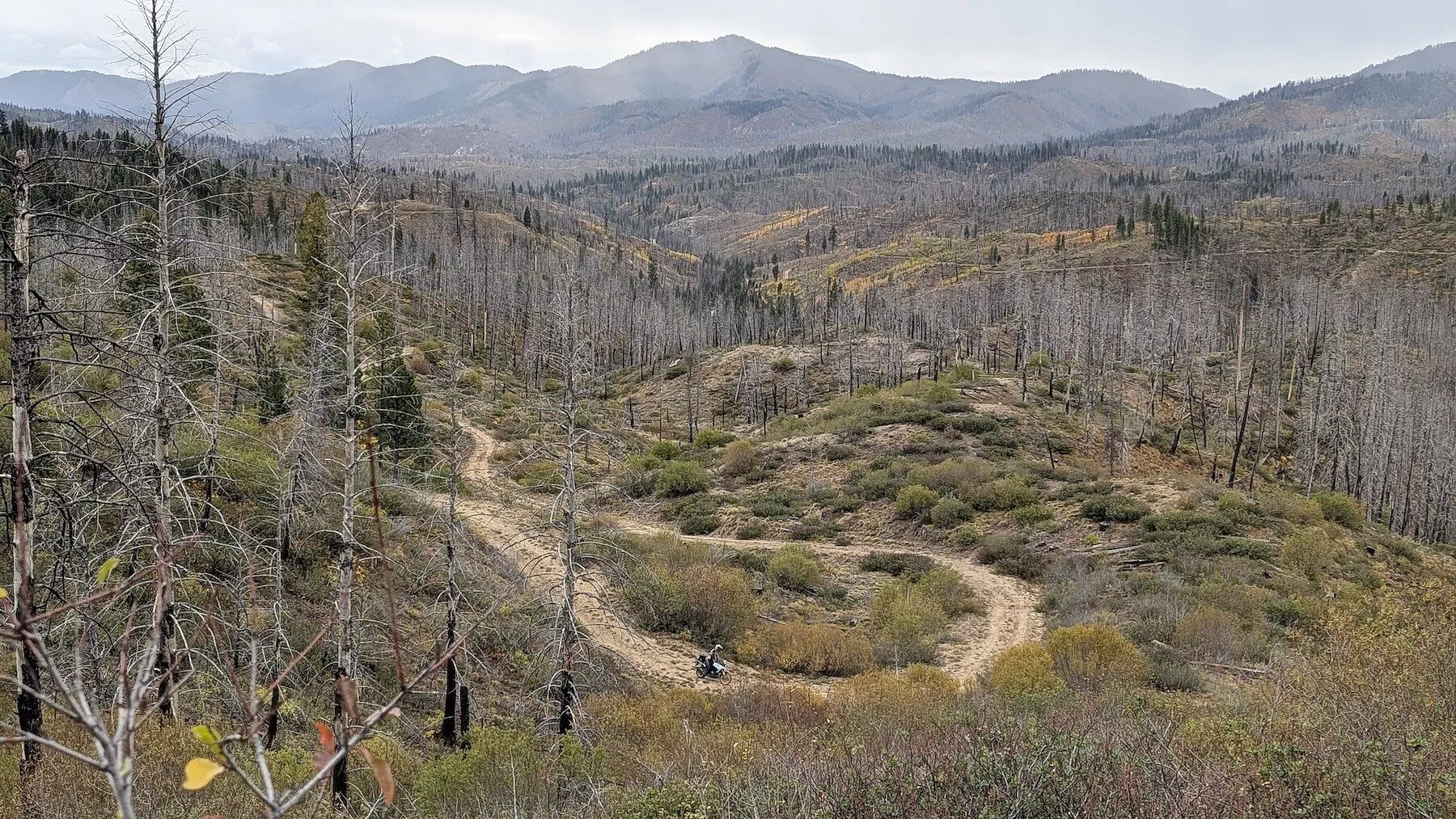
Wildfires in Idaho are an annual part of the natural cycle—mostly ignited by lightning, they reshape the landscape and ensure that forests remain young and resilient.
Mind's Eye - Is a Bear Lurking Around the Next Corner?
With every kilometer deeper into the endless forests of Idaho, the mind's eye grew wilder: for us Europeans, it almost felt like a grizzly could be lurking around every bend. In reality, only about 80 to 100 grizzlies live in Idaho, but there are between 20,000 and 30,000 black bears—a staggering number that reinforces the "Bear State" myth. In reality, however, these animals are shy, and the roar of two enduros tends to keep them at bay. Quite the opposite of the numerous deer and elk that repeatedly leaped right in front of our wheels throughout the week. Fortunately, we were always attentive enough to brake in time. To give the forest dwellers a little head start, we often honked before tight curves—whether that really keeps bears away is debatable. The fact is: there are no official tips for motorcyclists on dealing with bears. The common advice is always about camping, food waste, and garbage disposal. And one tip always applies when riding in a group: you don't have to be faster than the bear. You just can't be the slowest in the group.
Forest Wellness - Secluded Hot Pools Offered Breathtaking Serenity
On October 1st, we set out from Stanley, right in the heart of the high alpine landscape of the Sawtooth National Recreation Area. From there, our route led us downhill towards Boise, through endless forests, over passes like the Banner Summit https://maps.app.goo.gl/Lu5hufpHfEE27U559?g_st=ipc, and along wild rivers like Warm Springs Creek and Mores Creek. The day had it all: secluded gravel tracks, steep descents, breathtaking single trails, and numerous small river crossings. A particularly memorable stop was at the hot springs of Warm Springs Creek https://maps.app.goo.gl/TxmRynwmG2zKvYQt8?g_st=ipc. Here, where the steaming thermal water flows directly from the rocks into the rushing river, natural pools formed. We were able to take a dip in the middle of Idaho's wilderness—while nature roared around us, the warm pools offered pure relaxation, a wellness oasis under the open sky.
We continued on winding asphalt roads like the Ponderosa Pine Scenic Route, which shone with spectacular bends, and then on for hours along gravel passages by the Boise River, past the Arrowrock Reservoir and Lucky Peak Lake, until we finally arrived in Boise. We covered over 300 kilometers that day, about 80 percent of which was on gravel. The lasting impression was that Idaho is a rugged, wild, yet surprisingly accessible motorcycle destination—a paradise for those seeking adventure.
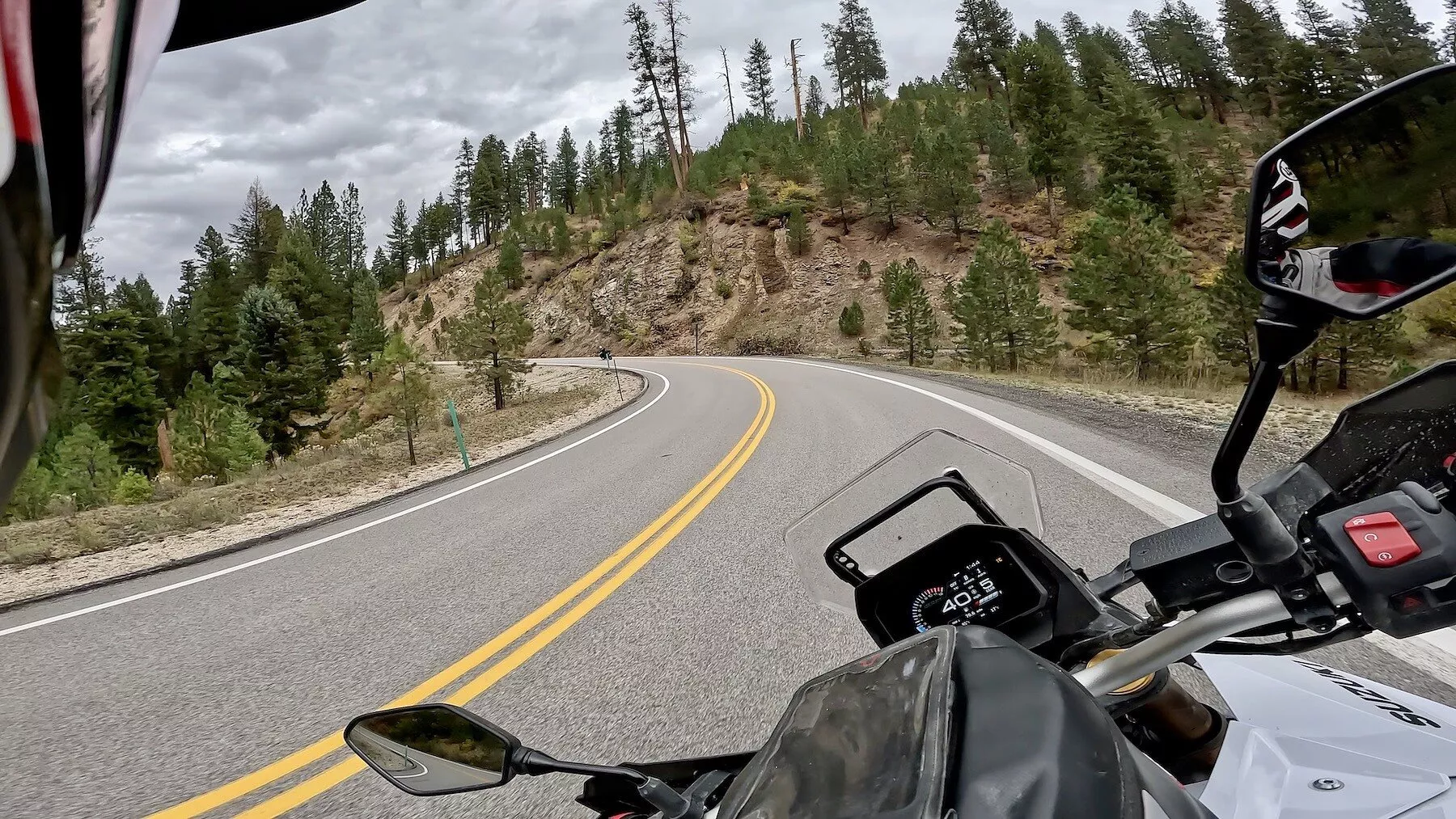
Sometimes we rode on asphalt! But with such wonderful curves, the ride was a delight!
Considerate Off-Road, Inattentive on the Highway
By now, we were nearing the end of our journey. Boise's charming city center offered us a pleasant evening, but the next day, a dull highway leg was on the agenda. We wrapped up the loop with a long stretch through the flat south. Besides plenty of potato fields, there was little for adventure riders to see here. The impressive waterfalls at Twin Falls served as a good pit stop. On the highway, we appreciated the stability and high seat comfort of the motorcycles. However, the ride was far from relaxing. While Americans were very considerate in the wilderness, they behaved differently here. On gravel rides, we consistently noticed how thoughtfully locals treated weaker road users. SUVs, pickups, and even ATVs always made room for us motorcyclists. Speeds were always reduced to allow us to overtake without being enveloped in dust. In the wilderness, there was a genuine sense of looking out for one another—the "togetherness" was truly palpable. On the highway, however, anonymity prevailed. It felt like people were even more distracted here than on European roads. Trucks and pickups often came dangerously close—requiring full concentration!
In many sections, we benefited from our Cardo Edge Bold communication solutions. We always rely on this for our tours. It allows us to better coordinate our photo shoots live in the saddle, direct camera runs, and discuss navigational uncertainties on the fly. A single charge lasts all day, and the operation is foolproof. And in tricky situations, they offer a bit of safety through seamless information exchange!
Soon We'll Have Crossed the Entire Country - Off-Road!
On the last day of our journey, we took another ride through the local mountains around Salt Lake City. Here, we once again experienced the concentrated thrill of enduro riding in the USA. This is exactly what adventure bikes are made for. Just yesterday, we completed a highway leg, made a morning detour to a breakfast place through hectic city traffic, and moments later, we found ourselves back in the solitude of the wilderness. Gravel roads are a normal part of the transportation infrastructure here. Off-road adventures are a regular part of leisure activities. Experiencing nature with a vehicle is quite normal here. The vast distances we covered couldn't have been managed with any other vehicle. Mountain bike: way too slow! Sport enduro: not enough comfort, not enough range! Off-road vehicle: far too uncomfortable and slow in stock form. The V-Stroms provided exactly the compromise we needed! They were built for this. By the end of the journey, it was clear to us—we're coming back! Next year, we want to close the gaps. Over the past few years, we've already mapped nearly a complete line of GPS tracks into our navigation systems. From the border in Mexico all the way up to Idaho. Mostly on gravel! We just need a few more tracks up to Canada, and we could say we've crossed the country—off-road! So look forward to exciting reports and videos in October 2026!
Archive links: Enduro Trip Utah Hardenduro
Archive link: Video Riding from San Diego to Las Vegas
Reports from the Yellowstone 2025 Series
Our Tips - 2700 km Adventure Trip Checklist
- Motorcycle: Suzuki V-Strom 800DE – robust, reliable, adventurous: Info and Prices
- Tires: Dunlop Trailmax Raid – perfect balance of road & gravel - Info
- Luggage: SW-Motech PRO Rearbag – lightweight & indestructible: Price and Info PLUS Waterproof Tank Bag for camera gear
- Apparel: Vanucci VAJ-4 / VAT-6 / VAG-4 / VAB-10 – tested from 1°C to 30°C: Link to the Jacket at LOUIS
- Communication: Cardo Packtalk Edge – always connected, even in the middle of nowhere: Buy Here
- Helmet: ARAI Tour-X5 – Premium comfort for long distances: Info and Designs
Motorcycle Adventure to Yellowstone National Park Images
Source: 1000PS

Tag 1 - Ankunft in Salt Lake City und
Tag 1 - Ankunft in Salt Lake City und






Tag 2 - Wyoming
Tag 2 - Wyoming

Tag 2 - Wyoming


Tag 2























Tag 3 - Island Park
















Tag 4 - Yellowstone Nationalpark




































Tag 5 - Über den Lemhi Pass nach Salmon




























Tag 6 - Von Salmon nach Stanley


Tag 6 - Von Salmon nach Stanley




















Tag 7 - Wellness im Wald - Am Weg in die Hauptstadt













Das Finale - Von Boise zurück nach Salt Lake City













